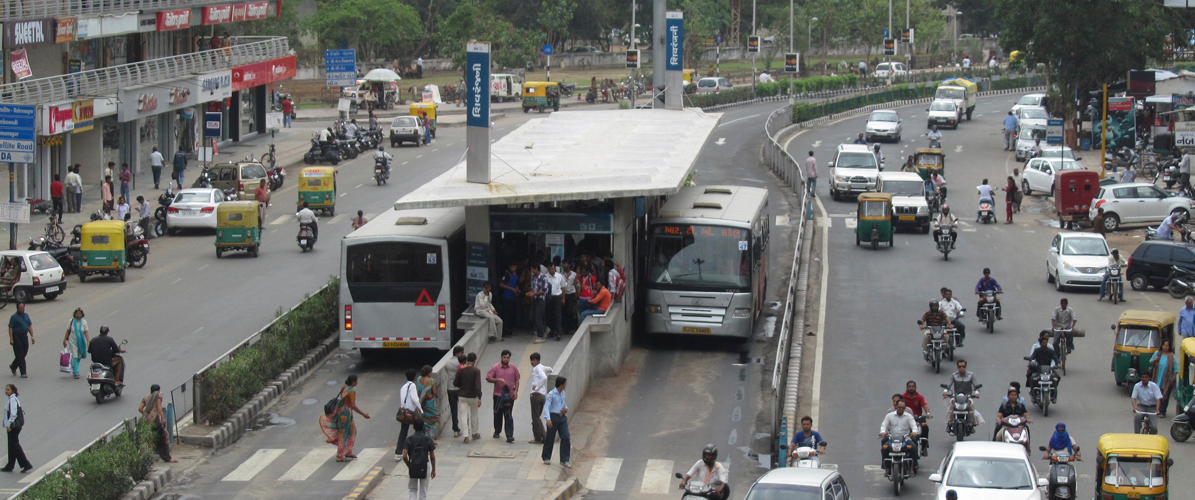Nestled along the banks of the Sabarmati river, and home to Gandhi’s ashram by the same name, Ahmedabad—or Amdavad as it was once known—is one of the fastest growing cities in India. Home to an estimated population of more than seven million, as per the 2015 UN estimates, the city has seen rapid urbanisation alongside the growth of its textile and automobile industry.
As the city’s development trajectory offshoots uncontrollably, urban sprawl has begun stifling many of its public utilities. And transportation is a sector which has faced some major challenges.
According to data furnished by the Planning Commission, the city records more than 22% of its trips by walking, 14% by cycling, and 5% by cycle-rickshaws. This means almost one out of every two commuter relies upon facilities such as walk and cycle. Even so, the usage of such modes have been declining speedily and correspondingly, private motor vehicle ownership has been off the roof. Over a span of three decades (1971-2001), the number of two-wheelers has grown by a gigantic 3877% .
 In such a scenario, sustainability is not only an option but a necessity. A thought which struck a chord with city officials and in the decade to follow, Ahmedabad has done well by welcoming sustainable mobility measures.
In such a scenario, sustainability is not only an option but a necessity. A thought which struck a chord with city officials and in the decade to follow, Ahmedabad has done well by welcoming sustainable mobility measures.
Janmarg: The People’s Way
In 2005, Ahmedabad welcomed us and other experts to reimagine bus-based transit. The Janmarg bus rapid transit (BRT) or ‘the people’s way’ started operations in 2009 and has grown from a 12-km corridor to an 97-km network of bus-only lanes. From its initial days, passenger numbers have increased from 18,000 to nearly 150,000 people per day.
As India’s first high-quality BRT system, Janmarg drove the conversation surrounding BRT and many cities were wooed by the proposition of a high-capacity bus network and sought our input.

Our Cities Ourselves: People-Centric Approach
To commemorate its 25th anniversary, ITDP Global organised the ‘Our Cities Ourselves’ programme in 2015. The programme looked to embrace the unique character of Ahmedabad and six prominent architects were brought on board to re-design six sites across the city. These streets were transformed into public spaces that were safe, comfortable, and accessible by all members of the society.
Central to the Our Cities Ourselves programme were the principles of transport in urban life: walk, cycle, connect, transit, mix, densify, compact, and shift. The designs were also prepared in consultation with a Citizens Council formed by a group of eminent Ahmedabad residents, to reflect what the people of the city desired.

Carefree on Car-free Sundays
Safe, child-friendly streets are not just a mirage of the past, but can be a beautiful reality even today. In 2009, Ahmedabad was the first city in India to host Car-Free Sundays in collaboration with us, Riverside School, and other partners. The initiative allowed citizens to experience the freedom of walking and cycling on safer car-free streets.

Transit-Oriented Development for the Win
As mentioned earlier, urban sprawl is a daunting reality of a fast urbanising Ahmedabad. If unchecked it could possibly bring various functionalities, transport included, to its feet. To check this complication, the Ahmedabad Urban Development Authority prepared the Development Plan 2021, in consultation with us, in 2013. The plan outlines several mechanisms to help reign in sprawl by promoting a compact city structure with higher densities in zones that have good public transport access. In short, ensuring more intense land uses within 200m on either sides of BRT and metro corridors.
Ahmedabad has been a trendsetter by all means and these measures are reflective of how the city aims to be perceived. That is, a vanguard in the sustainable mobility domain.











